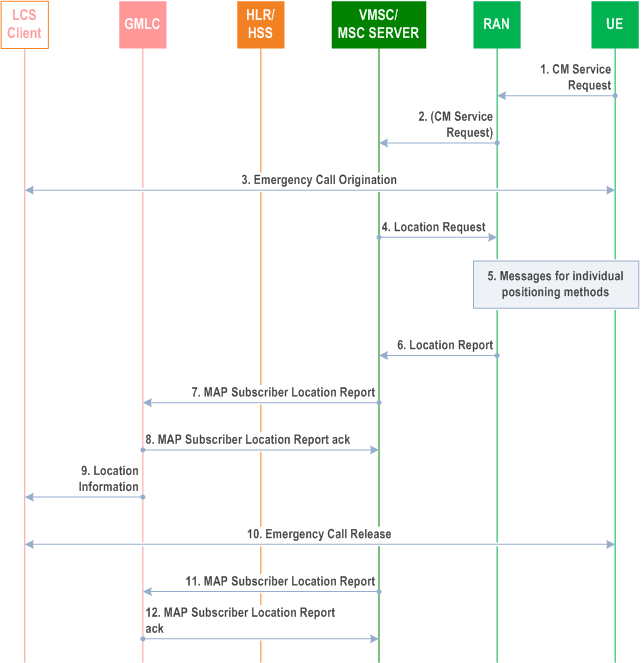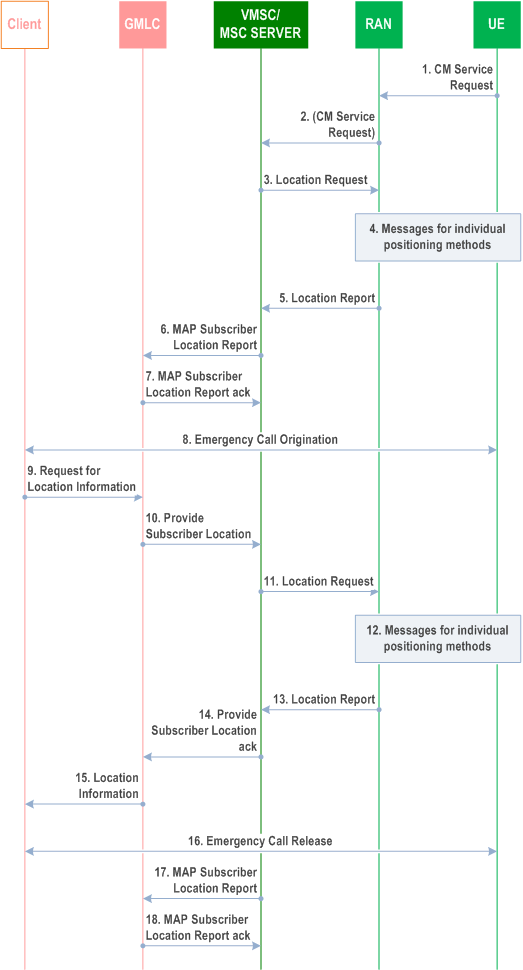Content for TS 23.271 Word version: 18.0.0
1…
5…
6…
6.2…
7…
8…
9…
9.1.1A…
9.1.2…
9.1.5…
9.1.6…
9.1.8…
9.1.9…
9.1.12…
9.1.13…
9.1.15…
9.1.19…
9.2…
9.2.2…
9.2.3…
9.3…
9.4…
9.5…
9.6…
10…
11…
A…
B…
E
F…
9.1.5 Network Induced Location Request (NI-LR)
9.1.5.1 Location Preparation Procedure
9.1.5.2 Positioning Measurement Establishment Procedure
9.1.5.3 Location Calculation and Release Procedure
9.1.5A NI-LR using Location Based Routing - applicable to North American Emergency Calls only
9.1.5A.1 Location Preparation Procedure
9.1.5A.2 Positioning Measurement Establishment Procedure
9.1.5A.3 Location Calculation and Release Procedure
9.1.5A.4 Location Preparation Procedure
9.1.5A.5 Positioning Measurement Establishment Procedure
9.1.5A.6 Location Calculation and Release Procedure
...
...
9.1.5 Network Induced Location Request (NI-LR) p. 72
Figure 9.4 illustrates how the initial position for an emergency service call is determined when the subscriber initiates the emergency call.

9.1.5.1 Location Preparation Procedure p. 72
Step 1.
An initially idle UE requests radio connection setup indicating a request for an Emergency Service call to the VMSC/MSC server via RAN.
Step 2.
RAN shall convey the CM service request to the core network. (Before having a CM connection there must be a radio connection.) The UE may identify itself using a TMSI, IMSI or IMEI.
Step 3.
The emergency call procedure is applied. The VMSC/MSC server determines based on the serving cell the appropriate emergency services client. The VMSC/MSC server, RAN and UE continue the normal procedure for emergency call origination towards that emergency services client. Depending on local regulatory requirements, the sending of call setup information into the PSTN may be delayed until either the UE's location has been obtained or the location attempt has failed or a PLMN defined timer has expired before location was obtained. If the serving cell serves an area that contains the service domain of multiple emergency services clients, the VMSC/MSC server may delay call setup and invoke location based routing procedures described in clause 9.1.5A. Call setup information sent into the PSTN may include the UE location (if already obtained) plus information that will enable the emergency service provider to request UE location at a later time (e.g. NA-ESRD or NA-ESRK in North America, or the ISUP/BICC IAM message with location number parameter set to MSC number and the calling party parameter set to MSISDN, in E.U.).
Step 4.
At any time after step 2, the VMSC/MSC server may initiate procedures to obtain the UE's location and optionally, velocity. These procedures may run in parallel with the emergency call origination. The VMSC/MSC server sends a Location Request message to RAN associated with the UE's current location area (see step 6 for a MT-LR). This message includes the QoS required for an emergency call.
9.1.5.2 Positioning Measurement Establishment Procedure p. 73
9.1.5.3 Location Calculation and Release Procedure p. 73
Step 6.
When a location estimate best satisfying the requested QoS has been obtained, RAN returns it to the VMSC/MSC server in a Location Report. As a national option, Cell ID positioning accuracy is allowed. RAN shall in its response include an indication whether the obtained location estimate satisfies the requested accuracy or not. The information of the positioning method used may be returned with the location estimate. If a location estimate could not be obtained, the RAN returns a location response containing a failure cause and no location estimate.
Step 7.
Depending on local regulatory requirements, the VMSC/MSC server may send a MAP Subscriber Location report to a GMLC associated with the emergency services provider to which the emergency call has been or will be sent. This message shall carry any location estimate returned in step 6 including the indication received from RAN whether the obtained location estimate satisfies the requested accuracy or not, the age of this estimate and may carry the MSISDN, IMSI and IMEI of the calling UE, the information about the positioning method used and the serving cell identity or SAI of the UE. In case of a SIM-less emergency call, or a non-registered (U)SIM emergency call, the IMEI shall be always sent and the MSISDN may be populated with a non-dialable callback number as specified in clause 6.4.3. In North America, any NA-ESRD and any NA-ESRK that may have been assigned by the VMSC/MSC server shall be included. In the E.U. the VMSC/MSC Server shall provide the identity of the PSAP to which the emergency call was connected. The message shall also indicate the event that triggered the location report. If location failed (i.e. an error result was returned by RAN in step 6), an indication of failure rather than a location estimate may be sent to the GMLC: the indication of failure is conveyed by not including a location estimate in the MAP Subscriber Location Report. The MSC/MSC server may record charging information.
Step 8.
The GMLC acknowledges receipt of the location information. The GMLC shall store the location information for later retrieval by the emergency services LCS client.
Step 9.
The GMLC may optionally forward the information received in step 8 to the emergency services LCS client. The GMLC may also record charging information. The client is expected to obtain the location information by requesting it from the GMLC. The information about the positioning method used may be sent with the location information from the GMLC to the LCS client.
Step 10.
At some later time, the emergency services call is released.
Step 11.
The MSC/MSC server sends another MAP Subscriber Location Report to the GMLC. This message may include the same parameters as before except that there is no position estimate and an indication of emergency call termination is included.
Step 12.
The GMLC acknowledges the MSC/MSC server notification and may then delete all information previously stored for the emergency call per national regulation.
9.1.5A NI-LR using Location Based Routing - applicable to North American Emergency Calls only p. 74
Figure 9.4A illustrates positioning for an emergency service call using location based routing.

9.1.5A.1 Location Preparation Procedure p. 75
Step 1.
An initially idle UE requests radio connection setup indicating a request for an Emergency Service call to the VMSC/MSC server via RAN.
Step 2.
RAN shall convey the CM service request to the core network. (Before having a CM connection there must be a radio connection.) The UE may identify itself using a TMSI, IMSI or IMEI.
Step 3.
The VMSC/MSC server determines that the serving cell serves an area that contains portions of multiple emergency services zones. Therefore, the VMSC/MSC server delays call setup and initiates procedures to obtain the UE's location for routing the emergency call to the emergency services LCS client. The VMSC/MSC server sends a Location Request message to RAN associated with the UE's current location area. This message includes the type of location information requested, the UE's location capabilities and a QoS with low delay and low horizontal accuracy.
9.1.5A.2 Positioning Measurement Establishment Procedure p. 75
9.1.5A.3 Location Calculation and Release Procedure p. 75
Step 5.
When a location estimate best satisfying the requested QoS has been obtained, RAN returns it to the VMSC/MSC server. If a location estimate could not be obtained, the RAN returns a location response containing a failure cause and no location estimate. If a failure is received, the VMSC/MSC server initiates emergency call setup using the normal NI-LR procedures.
Step 6.
The VMSC/MSC server sends a MAP Subscriber Location Report to a GMLC associated with the emergency services provider to which the emergency call will be sent. This message shall carry any location estimate returned in step 5, the age of this estimate and may carry the MSISDN, IMSI, IMEI of the calling UE, the information about the positioning method used and the serving cell identity or SAI of the UE. In case of a SIM-less emergency call, or a non-registered (U)SIM emergency call, the IMEI shall be always sent and the MSISDN shall be populated with a non-dialable callback number as specified in clause 6.4.3. The message shall also indicate the event that triggered the location report. Any NA-ESRD and NA-ESRK that was assigned by the VMSC/MSC server shall be included. The message shall also include an indication that the VMSC/MSC server supports the capability to replace an NA-ESRK or NA-ESRD value with the one assigned by the GMLC. The VMSC/MSC server and GMLC may record charging information.
Step 7.
The GMLC translates the location estimate into a zone identity and assigns either a NA-ESRK or a NA-ESRD, which was requested by the VMSC/MSC server. The GMLC shall include either the NA-ESRK value or the NA-ESRD value in the MAP Subscriber Location Report ack and send it to the VMSC/MSC server. The GMLC stores either the assigned NA-ESRD or the assigned NA- ESRK and any NA-ESRD that was sent by the VMSC/MSC server in step 6.
9.1.5A.4 Location Preparation Procedure p. 75
Step 8.
The emergency call procedure is applied. The VMSC/MSC server, RAN and UE continue the normal procedure for emergency call origination towards the appropriate emergency services client. Call setup information sent into the PSTN may include the UE location plus information that will enable the emergency service provider to request UE location at a later time (NA-ESRD or NA-ESRK in North America). The NA-ESRK or NA-ESRD used shall be the one received from the GMLC. If a NA-ESRK or NA-ESRD is not received from the GMLC then the VMSC/MSC server shall employ default routing for the call using a default NA-ESRK, default NA-ESRD or other default number as in clause 9.1.5.1 step 3.
Step 9.
At any time after step 8, the emergency services LCS client may request location information.
Step 10.
At any time after step 6, the GMLC may send a MAP Provide Subscriber Location message to the VMSC/MSC server. This message includes a QoS with higher delay and higher horizontal accuracy required for an emergency call. In case of a SIM-less emergency call, or a non-registered (U)SIM emergency call, the IMEI shall be included in the message.
If the GMLC is capable of determining whether the initial location satisfies the higher accuracy requirements for an emergency call, then the GMLC may not need to request for a higher accuracy location.
Step 11.
The VMSC/MSC server sends a Location Request message to RAN. This message includes the type of location information requested, the UE's location capabilities and requested higher accuracy QoS.
9.1.5A.5 Positioning Measurement Establishment Procedure p. 76
Step 12.
same as step 4.
9.1.5A.6 Location Calculation and Release Procedure p. 76
Step 13.
same as step 5.
Step 14.
The VMSC/MSC server returns the location information and its age, the information about the positioning method used and the serving cell identity or SAI of the UE to the GMLC. The GMLC shall replace the previously stored low accuracy location information with the higher accuracy information for later retrieval by the emergency services LCS client. The VMSC/MSC server and GMLC may record charging information.
Step 15.
The GMLC may forward the information received in the previous step to the emergency services LCS client. The client is expected to have requested this information from GMLC before. The information about the positioning method used may be sent with this location information from the GMLC to the LCS client.
Step 16.
same as step 10 for normal NI-LR.
Step 17.
same as step 11 for normal NI-LR.
Step 18.
same as step 12 for normal NI-LR.